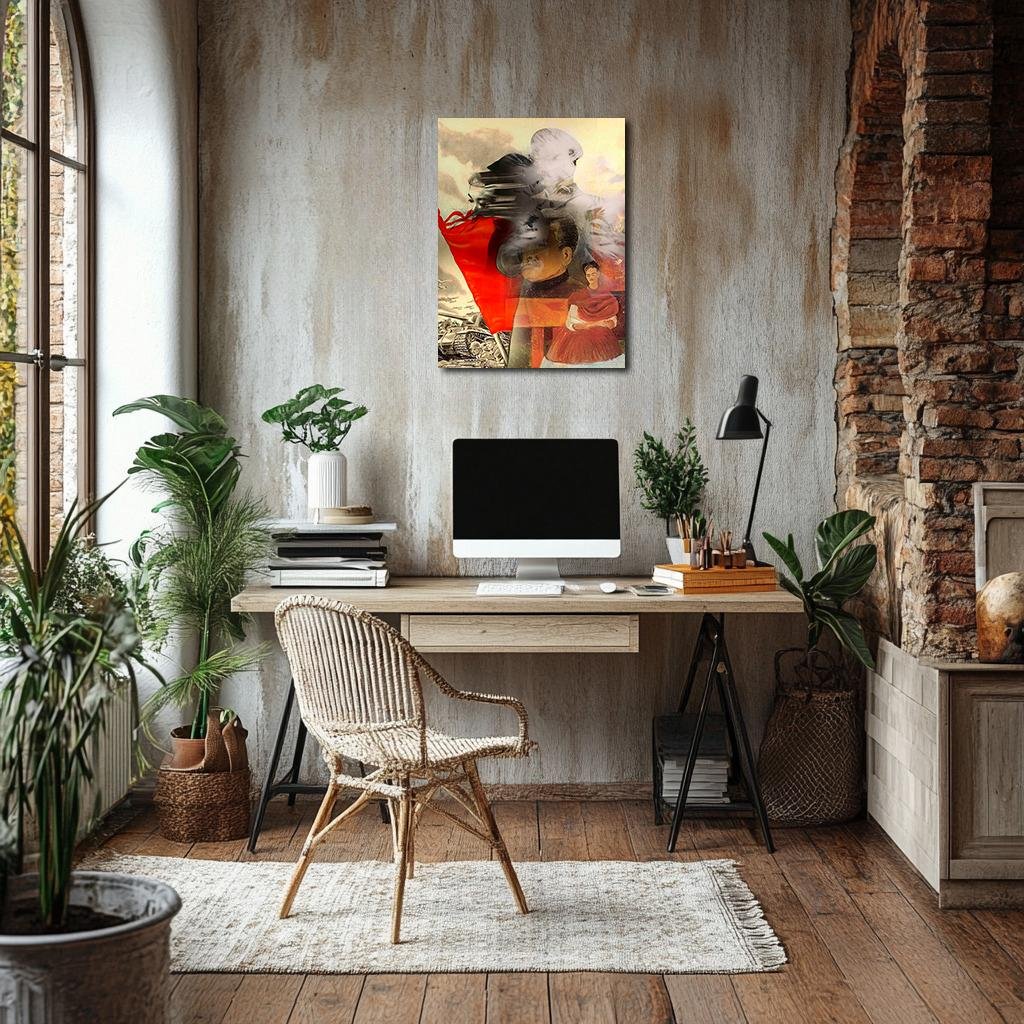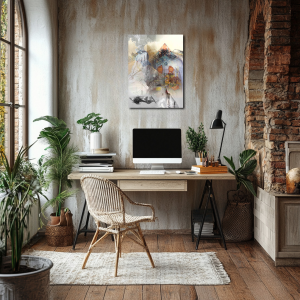Shadows of Devotion: Frida’s Quiet Revolution
Shadows of Devotion reimagines Frida Kahlo’s Self-Portrait with Stalin as a fractured dreamscape of ideology, endurance, and quiet rebellion. Through bruised grays, bleeding crimsons, ghosted whites, and dusty ochres, Kahlo’s solitary figure stands small yet defiant against the crumbling mythologies of war and power. In this swirling theater of loyalty and loss, the piece honors Frida’s desperate hope that even beneath the suffocating banners of history, the fragile truth of human survival endures.
Please see Below for Details…
Hotline Order:
Mon - Fri: 07AM - 06PM
404-872-4663
This conceptual reimagining of Frida Kahlo’s Self-Portrait with Stalin stretches her conflicted veneration of political power into a spectral theater where loyalty, pain, and disillusionment drift across shifting planes of history and personal survival. Titled Shadows of Devotion , the piece blurs the sharp edges of ideology into a misted dreamscape, where memory is fractured by violence, hope is tangled with betrayal, and personal identity battles beneath the heavy banners of belief.
At the core of the composition stands Frida’s unmistakable figure, small yet anchored, wrapped in her traditional red shawl—a stark human pulse amidst towering faces of political myth. Her posture, arms folded across her chest, captures both defiance and resignation, a body both guarded and exposed to the ideological storms roaring above. Stalin’s massive visage looms behind her, rendered not as a distinct portrait but as a dense, immovable mass—part icon, part obstacle, part fading ghost.
Above them, a swirling chaos of blurred figures emerges—soldiers, banners, and vaporous faces dissolving into clouds of smoke and war. A woman, hair whipping in the wind, clutches a bright crimson flag that pierces the left half of the piece, cutting across a backdrop of tanks, planes, and mechanized violence. Her face is both determined and hollowed, a mirror to Frida’s own silent entanglement with causes larger and harsher than human scale.
Color throughout Shadows of Devotion hums with tightly wound tension and muted fury. The composition is saturated with dusty reds, ranging from deep iron-rust shades to brighter, bleeding crimsons that signify both fervent passion and the blood cost of revolution. These reds are not glossy; they are worn and stained, bearing the exhaustion of prolonged struggle.
The industrial chaos in the lower left corner is rendered in bruised grays, gunmetal silvers, and ash-white smears, evoking the cold machinery of political ambition and its endless appetite for sacrifice. The planes, tanks, and bombs are barely differentiated from the smoke, suggesting that destruction has become so common it blends into the very air.
Frida’s own figure is painted with muted flesh tones—dusty siennas and tired terracottas—that reinforce her physical and emotional weariness. Her red shawl, vibrant but heavy, clings to her like a burden rather than a banner. She is neither triumphant nor defeated; she simply endures, a small force of humanity dwarfed by the monstrous faces of ideology towering around her.
Above and around Stalin’s shadowed face, the palette softens into ghostly whites and faded sepias. These ethereal colors suggest the inevitable erosion of all political mythologies, no matter how violently enforced. Stalin's portrait dissolves into mist, suggesting that even the most fearsome icons are eventually worn away by the passage of time and the frailty of human memory.
The sky behind the figures shifts from a dirty ochre into a polluted lavender-gray, creating a claustrophobic ceiling over the entire scene. There is no open space, no breath of freedom—only the heavy, static churn of history’s weight.
When I created Shadows of Devotion , I wanted to illuminate the complexity within Frida Kahlo’s late-life reverence for Stalin—not to simplify it as naive hero-worship, but to show it as a desperate tether to the idea of order and justice after years of personal chaos and bodily betrayal. Kahlo’s body had failed her, love had wounded her, and so she reached for a myth that promised strength and certainty, even as its own reality crumbled around her.
The compositional rhythm compresses downward: from the ghosted faces of soldiers and banners, through Stalin’s decaying visage, through the red river of the flag, finally landing on Frida’s solid, quiet form. The movement creates a gravitational pull toward the body—toward the inescapable truth that no ideology can erase the private agony of flesh and spirit.
In this vision, Frida Kahlo is neither blind nor uncritical. She stands at the crossroads of hope and history, loyal not to Stalin himself but to the idea that something stronger, something enduring, might yet be built from the wreckage.
Add your review
Your email address will not be published. Required fields are marked *
Please login to write review!
Looks like there are no reviews yet.








